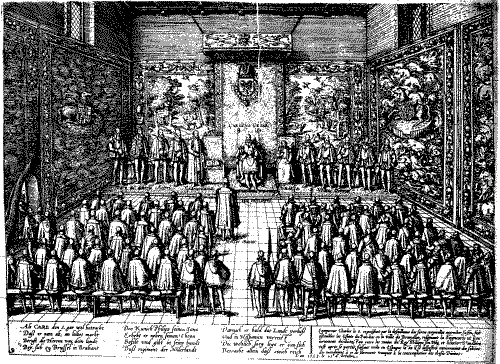
In October 22 1555, Charles gives up the maestrazgo of the order of the Golden Fleece, and in his place the gentlemen choose Felipe. The abdication of the Low Countries took place in the Palace of Brussels October 25 1555, before the General States of the seventeen counties of the Low Countries. Charles V was presented in the assembly supported by William of Orange, gentleman of the Fleece. In his lathe, the rest of the gentlemen, general, consultants and governors of the Low Countries, the Duke Manuel Filiberto of Saboya, his son Phillip and their sisters, Leonor and Mary of Austria. The act was opened by the consultant Filiberto of Saboya, taking the word Charles V. The answer to the Emperor was made in French by the bishop of Arras, Antonio Perrenot of Granvela, after apologizing Felipe of not dominating the language of the country better. The act was closed by the gobernadora Mary of Hungary and the Dr. Jacob Maso, síndico of Antwerp.

In a much more intimate act, the Emperor would abdicate January 16 1556 in his son his Kingdom of Castile, Aragon, Sicily and the Indias, as well as the maestrazgo of the military orders. It was the previous step to the parties of the XXII Chapter of the Golden Fleece, taken place in Antwerp between January 19-30 1556 and already presided over by the new king Phillip II. The artistic examples that they mention to the successoral relationship among Leon Leoni's figures incluen several medals with Charles' double image with Phillip. But mainly we will interest us the inscriptions of the victorious arch where a tableaux vivant acted that prayed: "Long live the king, blessed by the Lord God of Israel that sits down today in my throne, like in another time David when becoming adult wanted to make with his son." They were carried out two representations: one with the king in the throne with the symbols of power, and the other one with the king in the bed advising to their young son.
We should remember here that the origin of the order of the Golden Fleece goes back at 1429, when Phillip the Good, duke of Bourgandy, decided to rescue the noble spirit of the crusades, to try to restate the conquest of Jerusalem. This objective was also assumed by Phillip II until he had to brake before the Turk in Lepanto. In that time, the Order was mainly related with the States of the Low Countries whose heraldry (a black rampant lion on field of gold) it was supposed that it had in fact been gotten in the mount Sinai at the end of the XII century, through Phillip of Alsace.
- Jacques Le Boucq, "Eschauffault de la confrarye de la goude", en Le tresad- / mirable tri- / umphe de la / noble Order- / de la Thoi- / son dor / Chelebree de La / florisantte Ville / danvers Ian 1555 / Par Treshault & / Tresillustre Prince / Philippes Daustrice / Roy despaigne dangle- / terre de france & / duc de bourgoigne , f. 14 y 14v. Archivos del Toisón de Oro, Viena, cod. 24, Haus-, Hof- y Staatsarchiv (59 pages), 270 x 210 mm, Valenciennes, 12 de marzo de 1556.
- Cabrera de Córdoba, Historia de Felipe II, rey de España, lib. I, cap. VII, pp. 30s, 1601; ed. Junta de Castilla y León, Salamanca, 1998.
- Antonio de Herrera, Historia general del mundo de XVII años del tiempo del señor rey don Felipe II..., lib. II. cap. XVII, pp. 125-129, Valladolid, por Juan Godinez de Millis, 1606.
- E. Roobaert, "De triomfbogen opgericht te Antwerpen in 1556, ter gelegenheid van het 22ste kapittel van de Orde van het Gulden Vlies", en Bulletin Koninklijke Musea voor Schone Kunsten van België, p. 221-276, XI , 1962.
- Fernando Checa Cremades, "La formación del príncipe Felipe", en Felipe II, mecenas de las artes, p. 20 y 469, Nerea, Madrid, 1992. Although we take originally of this great book this information, it includes some errors, as locating the parties of the Chapter of the Golden Fleece in Brussels in 1555, when they took place in Antwerp in 1556. The tableaux vivant of the Chambre of Rhétorique of Antwerp (not of Gouda) called themself «de Goudbloem» (the Golden Flower). The complete text of the Latin inscription was: «Vivat rex, Benedictus dominus deus israel quy dedit hodie sedentem in solio meo videntibus oculis meis; Ut quondam David procerum plaudente senatu / arce sua natum regali in sede locavit / carolus augustus modo sic permisit habenas / filius ut regni plena ditione teneret / gaudet et ingenti nunc ergo antverpia plausu / Laetisonusq. tuba fecit aurea sidera clangor».